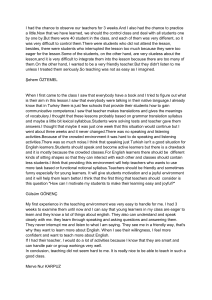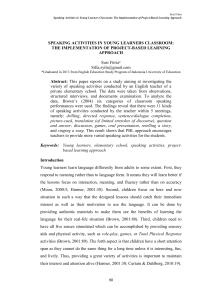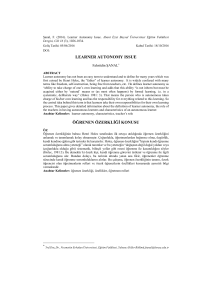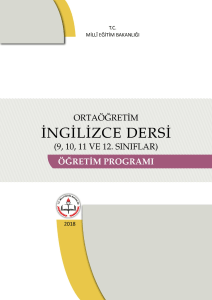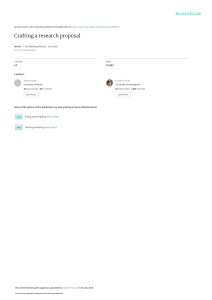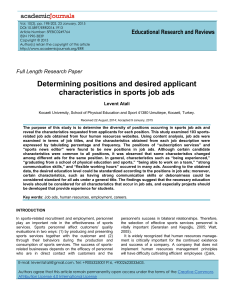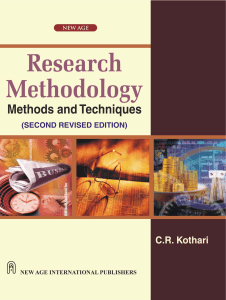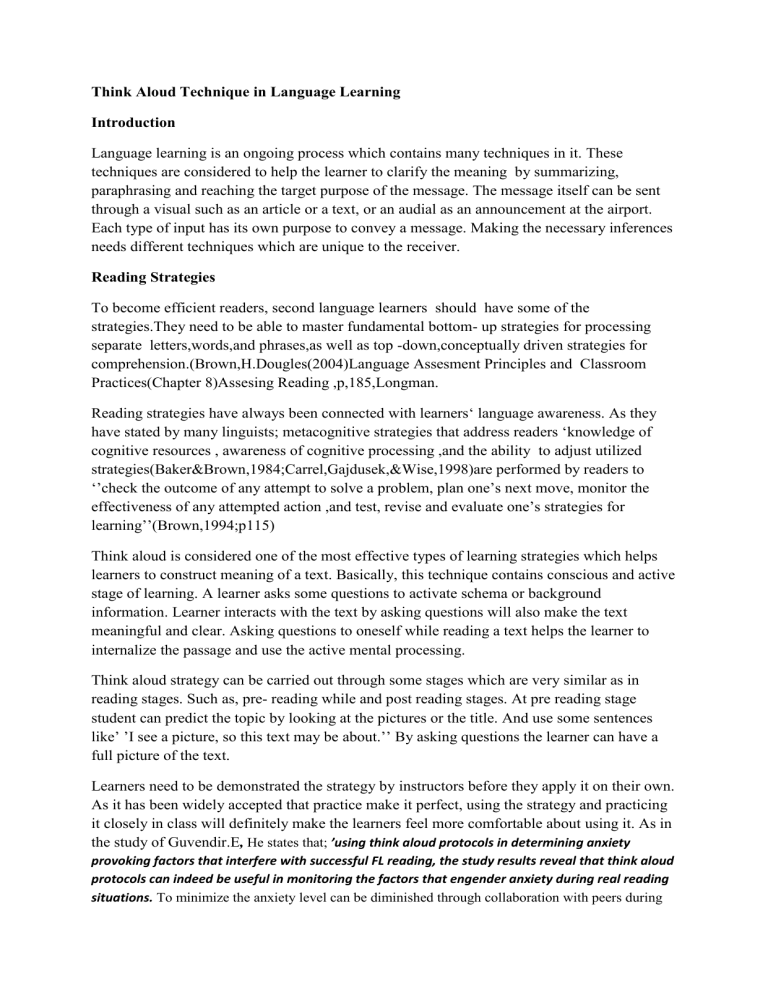
Think Aloud Technique in Language Learning Introduction Language learning is an ongoing process which contains many techniques in it. These techniques are considered to help the learner to clarify the meaning by summarizing, paraphrasing and reaching the target purpose of the message. The message itself can be sent through a visual such as an article or a text, or an audial as an announcement at the airport. Each type of input has its own purpose to convey a message. Making the necessary inferences needs different techniques which are unique to the receiver. Reading Strategies To become efficient readers, second language learners should have some of the strategies.They need to be able to master fundamental bottom- up strategies for processing separate letters,words,and phrases,as well as top -down,conceptually driven strategies for comprehension.(Brown,H.Dougles(2004)Language Assesment Principles and Classroom Practices(Chapter 8)Assesing Reading ,p,185,Longman. Reading strategies have always been connected with learners‘ language awareness. As they have stated by many linguists; metacognitive strategies that address readers ‘knowledge of cognitive resources , awareness of cognitive processing ,and the ability to adjust utilized strategies(Baker&Brown,1984;Carrel,Gajdusek,&Wise,1998)are performed by readers to ‘’check the outcome of any attempt to solve a problem, plan one’s next move, monitor the effectiveness of any attempted action ,and test, revise and evaluate one’s strategies for learning’’(Brown,1994;p115) Think aloud is considered one of the most effective types of learning strategies which helps learners to construct meaning of a text. Basically, this technique contains conscious and active stage of learning. A learner asks some questions to activate schema or background information. Learner interacts with the text by asking questions will also make the text meaningful and clear. Asking questions to oneself while reading a text helps the learner to internalize the passage and use the active mental processing. Think aloud strategy can be carried out through some stages which are very similar as in reading stages. Such as, pre- reading while and post reading stages. At pre reading stage student can predict the topic by looking at the pictures or the title. And use some sentences like’ ’I see a picture, so this text may be about.’’ By asking questions the learner can have a full picture of the text. Learners need to be demonstrated the strategy by instructors before they apply it on their own. As it has been widely accepted that practice make it perfect, using the strategy and practicing it closely in class will definitely make the learners feel more comfortable about using it. As in the study of Guvendir.E, He states that; ’using think aloud protocols in determining anxiety provoking factors that interfere with successful FL reading, the study results reveal that think aloud protocols can indeed be useful in monitoring the factors that engender anxiety during real reading situations. To minimize the anxiety level can be diminished through collaboration with peers during the think aloud process. Guiding the reader will provide a collaborative atmosphere between the learner and the instructor doing so, learner can find the usage of strategy use very easy. Modelling should be included in the first phase of the strategy training. The instructor can inform the learner about the technique beforehand. By this way, the learner will understand the objective and a purpose on his/her mind. By learning how to apply the procedures, learner is defined as an independent reader and the instructor should mention this to the learner in order to raise the motivation level of the learner. Modelling part can be the phase of the demonstration, we do part can be done with the learner so s/he can be more confident to rehearse before s/he actually practice. And at the last phase ‘’You do’ ’learner experience the strategy on his/her own under the guidance of the instructor. Learner can use various aids while practicing the newly acquired strategy. One of the most common one is to take notes while asking questions to the text. Instructors find fairly Beneficial to use sticky notes while practicing the strategy especially for the first time. By doing this learner can define where is the deficient part s/he needs to go over it again later. Instructor can also provide some support in the breakthrough parts where the learners asked questions. Guiding, restating the sentences or reminding the steps can be done by checking where the stick notes placed. Literature Review of Think Aloud Procedure There are many researches related to think aloud strategy. One of them is written by Leslie Oster which was publishes in ‘’The Reading Teacher, Vol.55, no 1(Sep.,2001), pp64-69. The article is mainly about an example of instruction ‘’think -aloud ‘’strategy in a classroom. The students were at 7th grades of reading/language arts classroom. The instructor applied the strategy in her class with the whole students. Instructor Leslie Oster stated her thoughts towards to reading strategy at the title of the article. ’Thinking aloud leads students to improved discussions, better understandings, and more enjoyment of literature. As it is not clearly stated in the article it is assumed that the students were native speakers of English. The reading passage was chosen by the instructor which was ‘’The Pearl ‘’by John Steinbeck. Firstly, think aloud strategy was demonstrated by the instructor explanations as well as examples. She presented the strategy use for the first paragraph of the chosen text, taking notes on the board while she is asking questions and negotiates meaning by herself. Secondly; students were provided a practice with the instructor as a whole class activity. Both the instructor and the students thought-aloud together. Then, the students were given opportunities to practice the strategy with their partners in class while they were monitored by the instructor. Students note down the questions -answers which includes predictions, inferences, summaries or comments. These inferences would be shred with the whole class to provide a discussion opportunity with the other classmates. The students then realized that how similar their comments were with the others. Having same ideas with each other, students felt more motivated and confident after using the strategy with pairs. Finally; students were given the last paragraph as an individual study to make follow the necessary steps and apply the strategy on their own. The students note down their own comments and used think about their own metacognition strategy as they think about how they think .With this study ,researcher or the instructor found out that the enjoyment was higher compared to the usual ones. The students collaboratively worked together and peer working fostered as well as individually they took their own learning responsibility with a homework in the end. The comments were supposed to written by each student. Besides the students own reading comprehension ability, weaknesses and strengths of the students were cleanly shown with this study. The instructor defined the problematic areas such as vocabulary or using context clues, to provide a future teaching plan for the students. Assessing the needs and finding solutions accordingly can be considered just some of the benefits for a learner. In deep, the students become responsible with their own learning, overcoming the difficulties on reading comprehension. As in the study by S.Bahri Ys,C .Nasir ,C.L.N.Rohiman,after applying the strategy with eight grade students in EFL reading class,stated that, think aloud strategy improves the ability of comprehending meaning in a reading context. It has been also stated that, cooperative learning provide a positive atmosphere for learners. The study aimed to present the idea of using the strategy will make the understanding clear and make the reading ability easier. Researchers believed that; verbalizing the text will provide awareness to the learners of thinking.Modelling stage is stated to be beneficial ,as the leaner will benefit of practicing of making predictions, creating images, or activating prior knowledge. The study revealed that,think aloud strategy significantly helped learners to find the main idea, supporting details,identifiying references,making inferences, and interpreting vocabulary. In the study of Anderson and M.Roit, the main purpose was to emphasize the factor of teacher in the instruction of reading strategies. Strategy training was presented the students to adolescents which is accepted as (12-16).The students were at level of 6-10 however their reading level was below grade 4 level. Also the study aimed to support the teacher to foster the learners reading ability. Especially for the ones who have reading disabilities.Once the teacher and the learners systematically cooperated to work each other they became eager to get involved in problem solving and felt less stressed in the time of the reading. There has been considerable amount of studies related to think aloud strategy application. Hereby stating some of the studies will have a delightful information the effect of strategy uses in class. Two of the studies’ details have stated below in order to provide an idea about the strategy. Method Participants Sixteen students who are ninth graders have participated in this study at Bahçeşehir College in Edirne. In the very beginning of the year, the proficiency test was applied to identify the levels of these students and when the results of it are compared, it is identified that their level of English is almost same. Selection of Reading Text The text has been chosen by the teacher from the book that she has to follow according to the weekly plan. The title of the text is ‘’An Amazing Story’ ‘It is about a rock climber who had an accident and had to take an extreme action in order to survive. Instrument and Procedure In this study, ‘’Think Aloud ‘’ technique was used to help students learn to monitor their thinking as they read and improves their comprehension. This technique teaches students to re-read a sentence, read ahead to clarify, and look for context clues to make sense of what they read. Firstly , the videos have been watched in the classroom to help learners comprehend how they apply this technique while reading a text. And then, the teacher has introduced the technique one more time by modelling it. After that, the teacher wants their students to work in pairs. Finally, one of these both students has read the text for his or her partner and the other one has asked some questions to his partner about the text. In this process, the teaches has only observed his/her students. At the end of this study, the teacher has interviewed with the students one by one and tried to find out how effective this technique is for his/her students. Findings Table 1: Think Aloud Assessment Statements and Average Think-Aloud Assessment Not much(1) Most of A the little(2) time(3) All of the time(4) 2 2 12 4 1 6 6 8 Forming mental pictures 1 8 6 8 Connecting what I read to what I already know 4 4 3 4 While I was reading, how much did I use these "think-aloud strategies? Making and revising predictions Creating analogies 2 6 6 4 Verbalizing confusing points 1 4 12 4 Using fix-up strategies 2 6 6 4 1,86 5,14 7,29 5,14 Average When we examined the findings that the teacher obtained via the ‘’Think-Aloud’’ assessments statements after the teacher applied the technique in the classroom , it is said that the learners are good at using the technique of ‘’Think Aloud’’ while reading the text about using think-aloud strategies, making and revisinf predictions , forming mental pictures,connecting what they read to what they already know , creating analogies,verbalizing confusing points and using fix-up strategies. Interview After using this technique in the classroom ,the teacher has interviewed with sixteen students in a same week.The main purpose of the teacher is to obtain more information about the technique of ‘’Think-Aloud’’ his /her learners think. According to the results of the interview despite of the fact that they have never heard this technique before, they have found it very applicable.On the other hand, they think that this technique can be time-consuming. Method Participants This study includes 14 seventh grade students studying at Bahçeşehir Middle School Lüleburgaz Campus. They all got the same exam before starting to school, that is acceptance exam of the school. They all have nearly same level of English. Reading Text Selection Text selection process was done by the researcher by considering the level of the students. The text titled ‘’ The Maasai Tribe’’ was chosen considering that students dealt with the migration topic for the last weeks. Instrument and Procedure To raise students’ consciousness level about their reading comprehension, the ‘’thinkaloud’’ procedure was used in this study. According to Oster(2001), Think aloud is a method in which learners verbalize their reading and opinions. As a method it has its own value because it helps researcher understand how learners/students think while they are reading a text. Firstly, the participants watched an informative video about Think-aloud method found by the researcher. Next week, the researcher introduced the method second time by modelling it in front of the students. By doing so, researcher thought that students would have a better understanding about the method. During modelling, researcher asked himself many questions about the text and wrote these questions on the board thinking that they may benefit his students’ thinking about the text. After, researcher asked students to make pairs and told them that they were going to apply this method on their reading. One by one, students read the text and their pairs asked them questions and wrote their answers on papers. They changed the roles and applied the same method again. While doing this, the researcher observed them and the process. Two weeks after this study, researcher interviewed with the students one by one and applied semi-instructed interview to have a deeper understanding about learners’ experiences about the method. Findings Questions Asked 1-What may this picture be about ? 2-What may this word mean ? 3-What word can be used instead of this word ? 4-What may this text be about ? 5-What does the title mean ? 6-What does it remind to you ? 7-What do you think that will happen in text ? 8-What did you learn from this text ? 9-Which part was the most important ? 10-Which paragraph was your favorite ? 11-What will happen after this paragraph ? 12-What is the weirdest part of the text ? 13-What do you think that text includes ? Total Number of Students 14 14 Number of Students Asking Questions Percentage 1 7,14% 100,00% 14 14 14 14 14 9 12 13 6 64,29% 85,71% 92,86% 42,86% 14 14 14 14 14 14 14 6 13 8 7 3 6 9 42,86% 92,86% 57,14% 50,00% 21,43% 42,86% 64,29% Table 1. Think Aloud questions and percentages When the table above is carefully examined, it is clear to see that students used the first question the least ( only one of 14) while they used the second question the most ( all of the students). While questions 4,5 and 8 are used a lot during their thinking aloud, they hardly used question eleven. Moreover, it is clearly seen that ,2 out of 4 mostly used questions are about the meanings of the words. While one question asks students’ expectation from the text, the last one asks him/her to explain the outcome s/he gets from the text. Interview After Think-Aloud was applied in classroom, interview was made in the classroom with six students two weeks after the actual study. The researcher’s aim was to gain a deeper understanding about what his students were thinking about Think-Aloud. So, he prepared a semi-instructed interview including 7 questions. All these questions focused on the usefulness and challenges of the method, difficulties students experienced during the study and their willingness to use this method on their future readings. Interview results showed that, despite students didn’t hear the name of this method before , they found it very easy and useful to apply as they think this method made their readings faster and more understandable especially for harder paragraphs. However, they stated that they had the most difficulty while trying to exchange the words with other words. They also stated that they didn’t have any idea about some words and naturally it was very hard for them to exchange a word for a word that they didn’t know. Lastly, they specified that Conclusion Regarding two of the studies which were applied in the same private schools, it can be stated that, think -aloud strategy helped the learners to be aware of their own learning process regardless of their age or level. Both of the studies students were second language learners of English. Generally foreign language learners find reading activities challenging. Thus, with these studies, it was aimed to create a curiosity and break the negative attitudes towards reading activities or texts. By modelling, monitoring and practicing either with teachers or peers, learners felt more motivated and encouraged. The study also presented the reality of having self-confidence contributed a lot during the strategy training. Learners are selfmotivated when they committed to learn to active a new strategy moreover, they also stated that, they have made the meaning clear and unknown vocabulary was no longer of a challenge. REFERENCES V.Anderson,M.Voit(1993)Planning and Implementing Colloborative Strategy Instruction for Delayed Readers in Grades 6-10,The Elementary School Journal(Vol.94,Number 2) Retrieved from https://core.ac.uk/download/pdf/4826284.pdf (Baker&Brown,1984;Carrel,Gajdusek,&Wise,1998) (Brown,H.Dougles(2004)Language Assesment Principles and Classroom Practices(Chapter 8)Assesing Reading ,p,185,Longman. (Brown,1994;p115) Guvendir,E.(2014)’Using Think-aloud Protocols to Identify Factors that Cause Foreign Language Reading Anxiety’’The Reading Matrix,14(2). Oster,L.(2001)’Using the Think Aloud for reading Instruction’The Reading Teacher,55(1)pp64-69 S.Bahri Ys,C .Nasir ,C.L.N.Rohiman,Using the Think Aloud Method in Teaching Reading Comprehension(2018)STUDIES IN ENGLISH LANGUAGE AND EDUCATION,5(1)148158.(INDONESIA) Partners in Reading - San Jose Public Library.(2014)Think Aloud-Retrieved from https://www.youtube.com/watch?v=HJJL7hQDM8I
